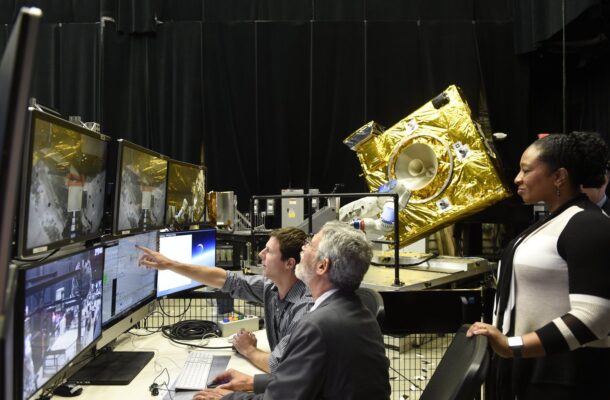Keep watching the skies!

If an asteroid threat emerged, Earth would need to be ready. Scientists are continually working to give the planet the best range of defensive strategies.
One day we might scan the skies and see it coming: an asteroid heading straight for Earth. Our response would depend on how far away the asteroid was when we saw it, how big it was and where exactly it was going to land. Four strategies are most likely, but many others are being explored to give us the best chance of deflecting a fast-travelling visitor from space.
‘Hide in the basement’ Or, in formal terms, civil defence – the response used for natural disasters such as hurricanes or tornadoes where there is a short-term warning. People would evacuate from the affected area if possible, and then hunker down and take cover. This would be the obvious choice for smaller objects, like those 1 metre across that enter Earth’s atmosphere a few times a year but don’t reach the ground intact.
It would also likely be the response to objects as big as the 20-metre asteroid that exploded over the Siberian city of Chelyabinsk in 2013, injuring more than 1500 people. Residents were caught unawares and had not taken cover, so these injuries were mostly caused by flying glass smashed in the impact shockwave. Even a small amount of warning would probably have kept everyone safe. For a relatively small, contained impact like this, the resources needed to prepare the city would be far less than the resources needed to try to deflect the asteroid.

The impact of a larger asteroid would be a catastrophe to a region, a continent or the entire world depending on its size. Even a smaller visitor like the one over Chelyabinsk would be more of a threat if it were on course for a large city – making evacuation harder and risking the loss of far more homes and infrastructure – or were going to land in the ocean and cause a tsunami. In these cases, there might be pressure to prevent the impact if possible.
Send in the nukes The most powerful tool humankind has for deflecting asteroids is also the most controversial one. Nuclear explosive devices are the go-to choice in movies, though scenarios for their use in planetary defence do not involve plucky astronauts setting charges and then escaping. It’s best to keep asteroids intact and move them as an easily tracked single body rather than blast them into numerous small pieces – some of which might still be heading for Earth.
Instead of burying the device near the centre of the threatening object, nuclear deflection scenarios involve stand-off bursts: the blast energy vaporises part of the asteroid and propels the space rock onto a new and safer path, far enough away from Earth that radiation and fallout wouldn’t be a problem.
Last-ditch scenarios involving nuclear devices could also be considered, though the side effects of using them for mitigation very close to Earth might be as bad as the consequences of an impact itself. And there is no way to try them out ahead of an actual threat: nuclear devices have been tested on Earth for close to 80 years, but it is against international law to test them in space.

Ram it with a spaceship The kinetic impactor (KI) technique could provide a third option – and it can be (and is being) tested. The KI technique is very simple: ram a spacecraft into the asteroid of concern and use the spacecraft’s momentum to change the momentum (and orbit) of the asteroid.
The Double Asteroid Redirection Test (DART), launched in November 2021, will attempt this technique. DART will target Dimorphos, a 160-metre moon of the 780-metre asteroid Didymos, and aim to change Dimorphos’ orbit around Didymos in late September 2022. The change will be small, but measurable from Earth. KI missions would provide a non-nuclear option for deflecting objects up to a few hundred metres across, especially if a series of KIs are sent and each gives the asteroid a small tap that together add up to a larger shove.

Let gravity do the work The gravity tractor is an elegant concept that uses a law of physics: even small masses can have a strong gravitational pull if they are very close by. The technique would involve operating a spacecraft of very large mass very near the asteroid of concern, and using the mass of the spacecraft to attract the asteroid. Because the spacecraft position could be controlled it could tug the asteroid in any direction and change its orbit so it misses the Earth.
Unlike nuclear devices or kinetic impactors, which make the change all at once, the gravity tractor is a slow-acting approach that could take decades to do the job. It is best suited for smaller objects and – of course – objects discovered a very long time before they are likely to reach Earth. The gravity tractor also allows a much more precise result than the other approaches.

Planetary defenders have come up with other options for deflecting asteroids, but these need more study to see how realistic they are. A passive option involves partly or wholly changing the brightness of the threatening asteroid and allowing a non-gravitational force (known as the Yarkovsky effect) to change the asteroid’s orbit. This would be a very long-term undertaking.
Another option would be to station a spacecraft with a powerful laser near the asteroid and vaporise the surface below, which would both reduce the mass of the asteroid and serve as a tiny rocket to change its orbit. But this would require a very powerful laser indeed, and an appropriately large power source and/or set of solar panels. Another approach would be to attach a tether many kilometres long to the asteroid, which would effectively change its centre of mass and lead to a change in orbit.
Asteroid impacts are unique disaster scenarios because they can be prevented altogether if we have enough warning. Thousands upon thousands of asteroids orbit near Earth, and scientists are continually cataloguing them to try to ensure anything on a collision course is found as early as possible. Should an actual threat emerge, the approach we take will also depend on the response from the specific country (or countries) affected, and how well the international community can cooperate via committees at the United Nations.
In the meantime, scientists will keep watching the skies and working on techniques to send space visitors on their way before they land on Earth’s doorstep.
Originally published under Creative Commons by 360info™.
Andrew S. Rivkin is a planetary astronomer at the Johns Hopkins University Applied Physics Laboratory.













